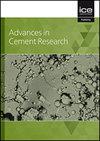Effect of use of retardant chemical additives in concrete on rebar corrosion
IF 1.3
4区 工程技术
Q3 CONSTRUCTION & BUILDING TECHNOLOGY
引用次数: 0
Abstract
Reinforced concrete (RC) is one of the most widely used building materials. However, RC, especially in coastal seaside or humid environments, can suffer reinforcement corrosion with the result that the reinforcement fails to perform its function over time. The effect of a retarder additive used to eliminate loss of consistency in hot, windy and humid weather on the corrosion of RC elements was investigated in this work. Four different concrete types were assessed, with 0%, 1%, 1.5% and 2% additions of the chemical additive. Along with accelerated corrosion and pressure tests, physical properties such as electrical resistivity, water absorption, porosity, unit weight and capillary water absorption were also determined. The results of this work indicate that the use of up to 2% of the setting retarder did not pose a problem in terms of the physical and mechanical properties of the concrete. However, in terms of the frequently encountered corrosion problem, the use of 1.5% is more appropriate. Many chemical additives are used for different purposes in concrete and it is suggested that, alongside physical and mechanical properties, durability characteristics should also be examined when determining the suitable ratios of these additives.混凝土中使用阻燃化学添加剂对钢筋腐蚀的影响
钢筋混凝土是应用最广泛的建筑材料之一。然而,钢筋混凝土,特别是在沿海海边或潮湿环境中,可能会遭受钢筋腐蚀,导致钢筋随着时间的推移而无法发挥其功能。本文研究了在高温、多风和潮湿天气中用于消除稠度损失的缓凝剂添加剂对钢筋混凝土构件腐蚀的影响。对四种不同类型的混凝土进行了评估,分别添加0%、1%、1.5%和2%的化学添加剂。随着加速腐蚀和压力测试,还确定了电阻率、吸水率、孔隙率、单位重量和毛管吸水率等物理性能。这项工作的结果表明,使用高达2%的凝结缓凝剂不会对混凝土的物理和机械性能造成问题。但是,对于经常遇到的腐蚀问题来说,使用1.5%更为合适。许多化学添加剂在混凝土中用于不同的目的,建议在确定这些添加剂的合适比例时,除了物理和机械性能外,还应检查耐久性特性。
本文章由计算机程序翻译,如有差异,请以英文原文为准。
求助全文
约1分钟内获得全文
求助全文
来源期刊

Advances in Cement Research
工程技术-材料科学:综合
CiteScore
3.70
自引率
5.00%
发文量
56
审稿时长
3.2 months
期刊介绍:
Advances in Cement Research highlights the scientific ideas and innovations within the cutting-edge cement manufacture industry. It is a global journal with a scope encompassing cement manufacture and materials, properties and durability of cementitious materials and systems, hydration, interaction of cement with other materials, analysis and testing, special cements and applications.
 求助内容:
求助内容: 应助结果提醒方式:
应助结果提醒方式:


